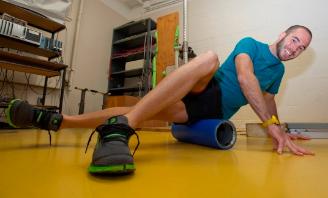Research investigates self treatment for sore muscles
 Muscular dysfunction can be caused by acute or chronic stressors such as tightness, overuse, inflammation, physical trauma, or structural imbalances causing hardening fibrous connections between the layers of myofascia (a tough sheet of connective tissue that wraps around and through all of our muscles and assists in the attachment of muscle to bone). If left untreated, it can lead to altered joint function, resulting in pain and other pathological conditions.
Muscular dysfunction can be caused by acute or chronic stressors such as tightness, overuse, inflammation, physical trauma, or structural imbalances causing hardening fibrous connections between the layers of myofascia (a tough sheet of connective tissue that wraps around and through all of our muscles and assists in the attachment of muscle to bone). If left untreated, it can lead to altered joint function, resulting in pain and other pathological conditions.
In the past, muscular dysfunction has been treated with massage, acupuncture, electrical stimulation and assisted myofascial release. Human Kinetics and Recreation (HKR) graduate student Graham MacDonald along with Drs. Duane Button and Dave Behm are studying self-myofascial release (SMR) treatment such as the foam roller, which does not need to be done by a therapist and requires very inexpensive equipment.
"SMR is a treatment currently being used in inactive, athletic and clinical populations to help alleviate myofascial induced-muscle dysfunction or taut bands," explained Mr. MacDonald. "For this, individuals use their body weight on a myofascial roller to exert pressure on the opposing myofascia. As the person changes their body position, they can isolate and treat specific muscle areas."
Although this treatment is becoming more popular, MacDonald notes there is limited research on how effective it is and only anecdotal reports that SMR improves range of motion (ROM) and muscle function. "Myofascia plays a fundamental role in how our muscles function and if myofascial treatment is already being used widely, we'd like to know more about the duration, frequency, and intensity that's needed to improve muscular function and its affect on muscle performance."
MacDonald and the rest of group hope to improve our understanding of the impacts of SMR as well as proper muscle positioning on the myofascial roller. "SMR techniques may be a valuable tool to decrease injury as well as decreasing the incidence of musculoskeletal problems. If myofascial rollers can provide similar relief as therapists manipulating trigger points, they would provide a positive and inexpensive means for alleviating pain, preventing muscle stiffness and improving daily functioning especially for those with skeletal muscle issues such as fibromyalgia and the elderly."
With $15,000 from Theraband and in-kind support from HKR, the researchers will be studying healthy, university-aged research participants, hoping to provide guidance on how SMR impacts performance, health and well-being.